Security Management System (SMS) in Singapore's Aviation Industry
VerifiedAdded on 2023/04/20
|16
|3933
|257
Report
AI Summary
This report provides a detailed overview of the Security Management System (SMS) within the aviation industry, specifically focusing on Singapore. It begins with an executive summary and table of contents, followed by an introduction to SMS and its importance. The report then delves into the critical components and elements of SMS as per the ICAO framework, including safety policy and objectives, safety risk management, safety assurance, and safety promotion. It highlights the importance of SMS in managing aviation safety and the entities responsible for setting SMS standards. The report explores the evolution of SMS over time and examines multiple types of safety cultures contributing to its efficiency, concluding with a summary of key findings and references.
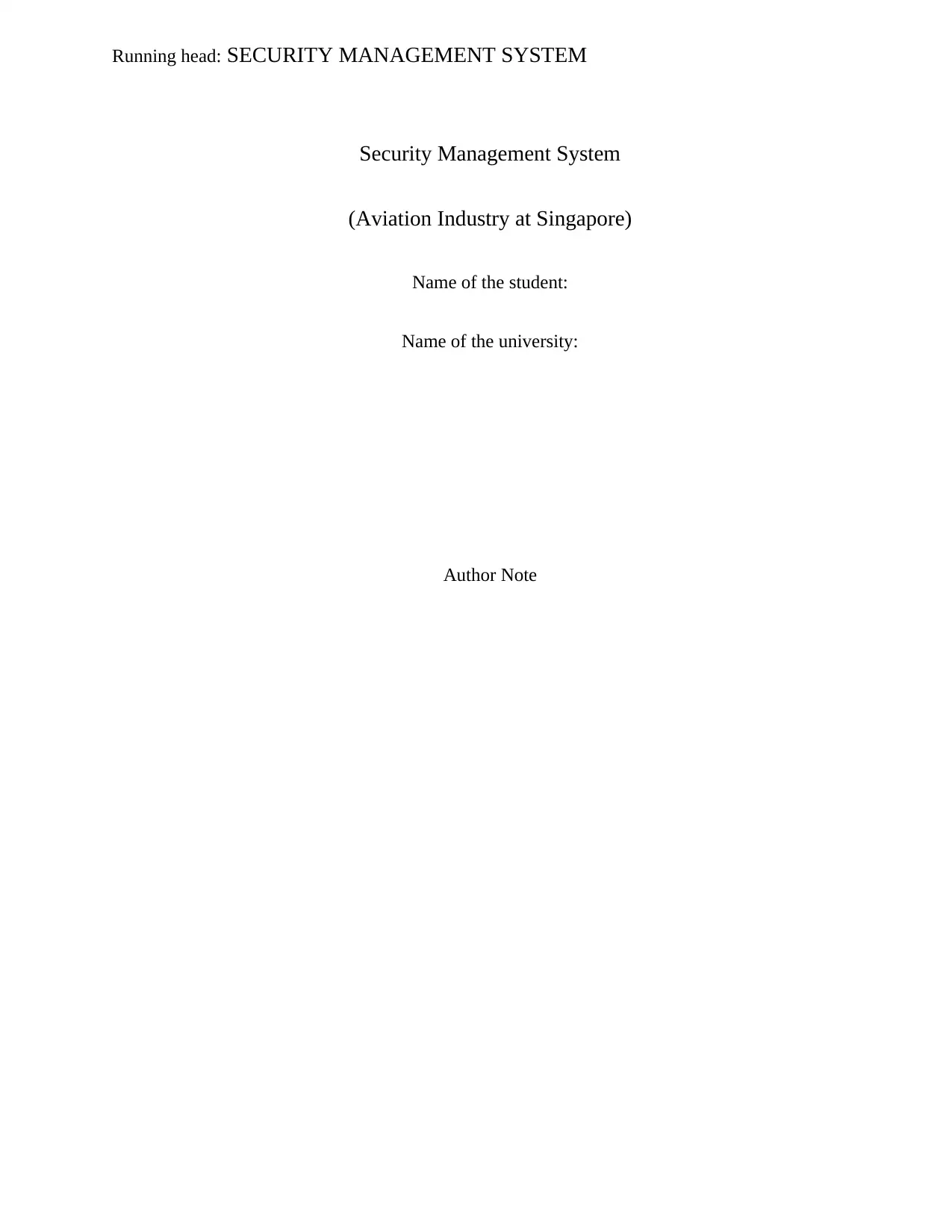
Running head: SECURITY MANAGEMENT SYSTEM
Security Management System
(Aviation Industry at Singapore)
Name of the student:
Name of the university:
Author Note
Security Management System
(Aviation Industry at Singapore)
Name of the student:
Name of the university:
Author Note
Paraphrase This Document
Need a fresh take? Get an instant paraphrase of this document with our AI Paraphraser
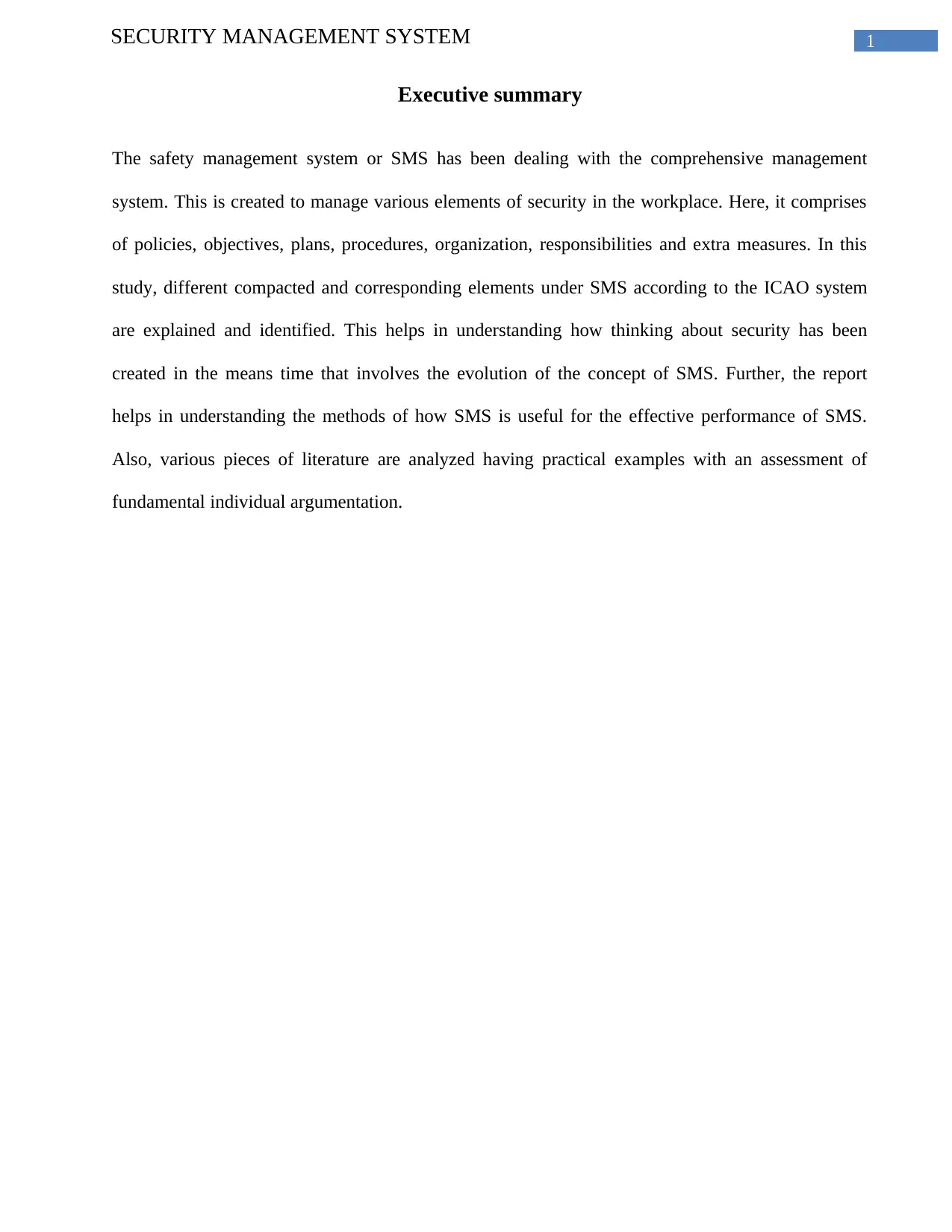
1SECURITY MANAGEMENT SYSTEM
Executive summary
The safety management system or SMS has been dealing with the comprehensive management
system. This is created to manage various elements of security in the workplace. Here, it comprises
of policies, objectives, plans, procedures, organization, responsibilities and extra measures. In this
study, different compacted and corresponding elements under SMS according to the ICAO system
are explained and identified. This helps in understanding how thinking about security has been
created in the means time that involves the evolution of the concept of SMS. Further, the report
helps in understanding the methods of how SMS is useful for the effective performance of SMS.
Also, various pieces of literature are analyzed having practical examples with an assessment of
fundamental individual argumentation.
Executive summary
The safety management system or SMS has been dealing with the comprehensive management
system. This is created to manage various elements of security in the workplace. Here, it comprises
of policies, objectives, plans, procedures, organization, responsibilities and extra measures. In this
study, different compacted and corresponding elements under SMS according to the ICAO system
are explained and identified. This helps in understanding how thinking about security has been
created in the means time that involves the evolution of the concept of SMS. Further, the report
helps in understanding the methods of how SMS is useful for the effective performance of SMS.
Also, various pieces of literature are analyzed having practical examples with an assessment of
fundamental individual argumentation.
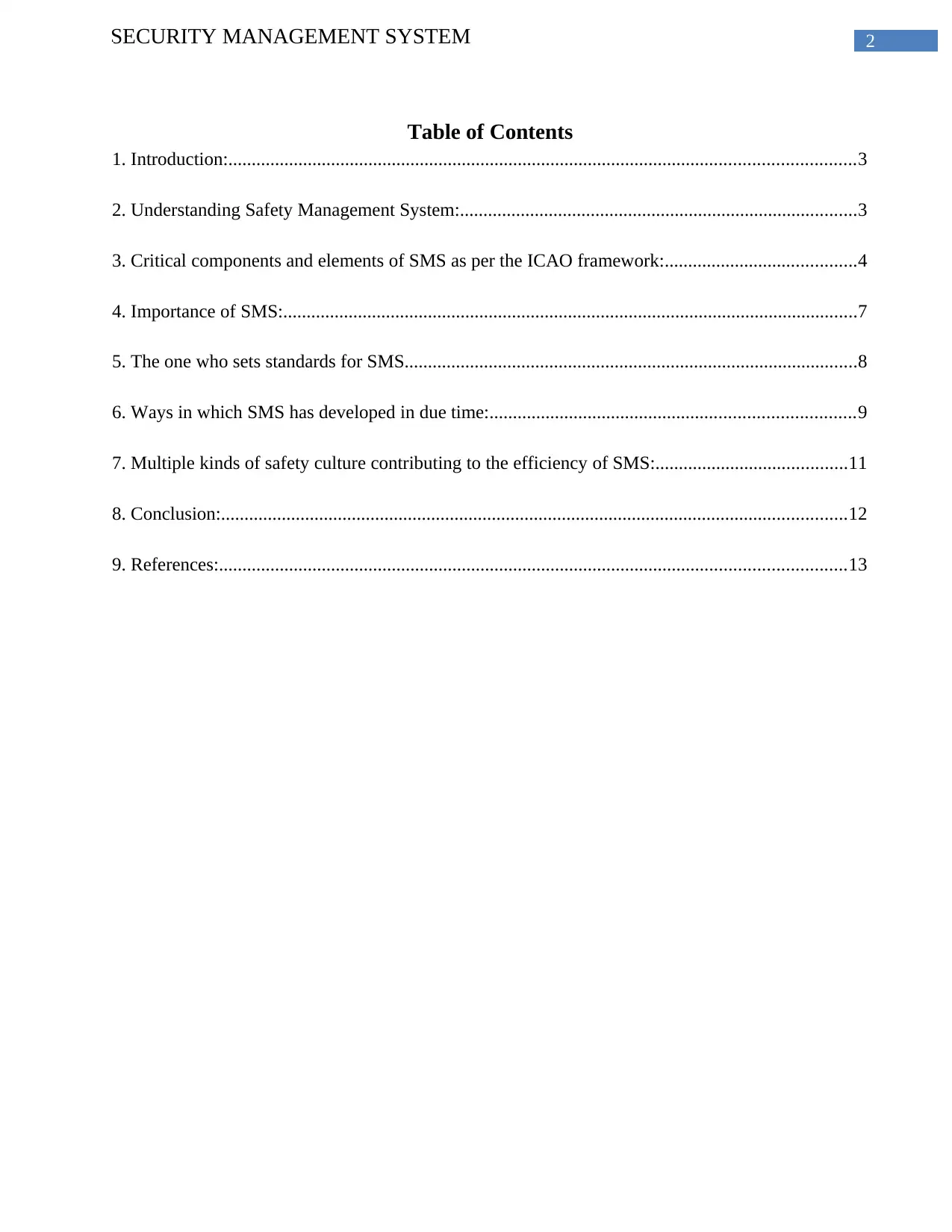
2SECURITY MANAGEMENT SYSTEM
Table of Contents
1. Introduction:......................................................................................................................................3
2. Understanding Safety Management System:.....................................................................................3
3. Critical components and elements of SMS as per the ICAO framework:.........................................4
4. Importance of SMS:...........................................................................................................................7
5. The one who sets standards for SMS.................................................................................................8
6. Ways in which SMS has developed in due time:..............................................................................9
7. Multiple kinds of safety culture contributing to the efficiency of SMS:.........................................11
8. Conclusion:......................................................................................................................................12
9. References:......................................................................................................................................13
Table of Contents
1. Introduction:......................................................................................................................................3
2. Understanding Safety Management System:.....................................................................................3
3. Critical components and elements of SMS as per the ICAO framework:.........................................4
4. Importance of SMS:...........................................................................................................................7
5. The one who sets standards for SMS.................................................................................................8
6. Ways in which SMS has developed in due time:..............................................................................9
7. Multiple kinds of safety culture contributing to the efficiency of SMS:.........................................11
8. Conclusion:......................................................................................................................................12
9. References:......................................................................................................................................13
⊘ This is a preview!⊘
Do you want full access?
Subscribe today to unlock all pages.

Trusted by 1+ million students worldwide
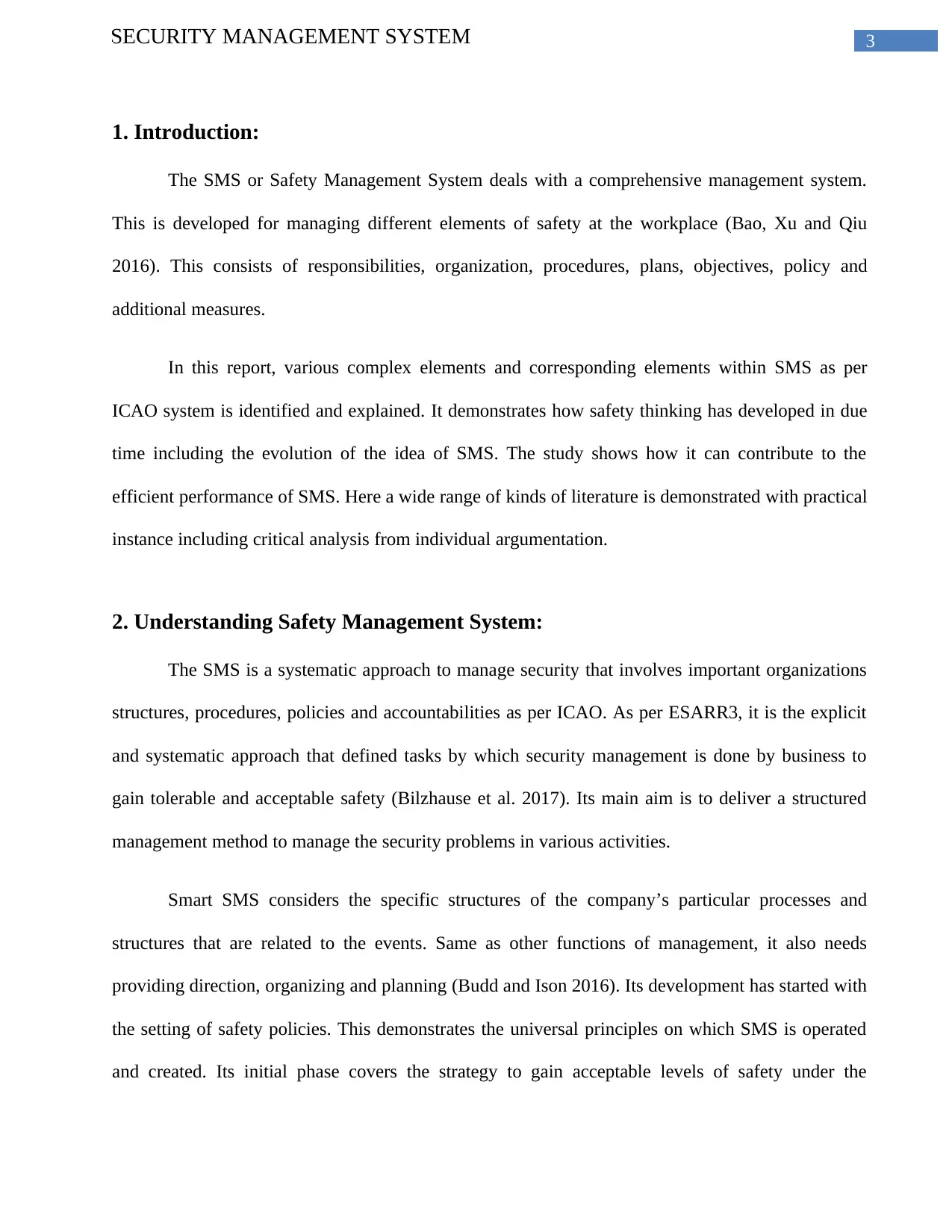
3SECURITY MANAGEMENT SYSTEM
1. Introduction:
The SMS or Safety Management System deals with a comprehensive management system.
This is developed for managing different elements of safety at the workplace (Bao, Xu and Qiu
2016). This consists of responsibilities, organization, procedures, plans, objectives, policy and
additional measures.
In this report, various complex elements and corresponding elements within SMS as per
ICAO system is identified and explained. It demonstrates how safety thinking has developed in due
time including the evolution of the idea of SMS. The study shows how it can contribute to the
efficient performance of SMS. Here a wide range of kinds of literature is demonstrated with practical
instance including critical analysis from individual argumentation.
2. Understanding Safety Management System:
The SMS is a systematic approach to manage security that involves important organizations
structures, procedures, policies and accountabilities as per ICAO. As per ESARR3, it is the explicit
and systematic approach that defined tasks by which security management is done by business to
gain tolerable and acceptable safety (Bilzhause et al. 2017). Its main aim is to deliver a structured
management method to manage the security problems in various activities.
Smart SMS considers the specific structures of the company’s particular processes and
structures that are related to the events. Same as other functions of management, it also needs
providing direction, organizing and planning (Budd and Ison 2016). Its development has started with
the setting of safety policies. This demonstrates the universal principles on which SMS is operated
and created. Its initial phase covers the strategy to gain acceptable levels of safety under the
1. Introduction:
The SMS or Safety Management System deals with a comprehensive management system.
This is developed for managing different elements of safety at the workplace (Bao, Xu and Qiu
2016). This consists of responsibilities, organization, procedures, plans, objectives, policy and
additional measures.
In this report, various complex elements and corresponding elements within SMS as per
ICAO system is identified and explained. It demonstrates how safety thinking has developed in due
time including the evolution of the idea of SMS. The study shows how it can contribute to the
efficient performance of SMS. Here a wide range of kinds of literature is demonstrated with practical
instance including critical analysis from individual argumentation.
2. Understanding Safety Management System:
The SMS is a systematic approach to manage security that involves important organizations
structures, procedures, policies and accountabilities as per ICAO. As per ESARR3, it is the explicit
and systematic approach that defined tasks by which security management is done by business to
gain tolerable and acceptable safety (Bilzhause et al. 2017). Its main aim is to deliver a structured
management method to manage the security problems in various activities.
Smart SMS considers the specific structures of the company’s particular processes and
structures that are related to the events. Same as other functions of management, it also needs
providing direction, organizing and planning (Budd and Ison 2016). Its development has started with
the setting of safety policies. This demonstrates the universal principles on which SMS is operated
and created. Its initial phase covers the strategy to gain acceptable levels of safety under the
Paraphrase This Document
Need a fresh take? Get an instant paraphrase of this document with our AI Paraphraser
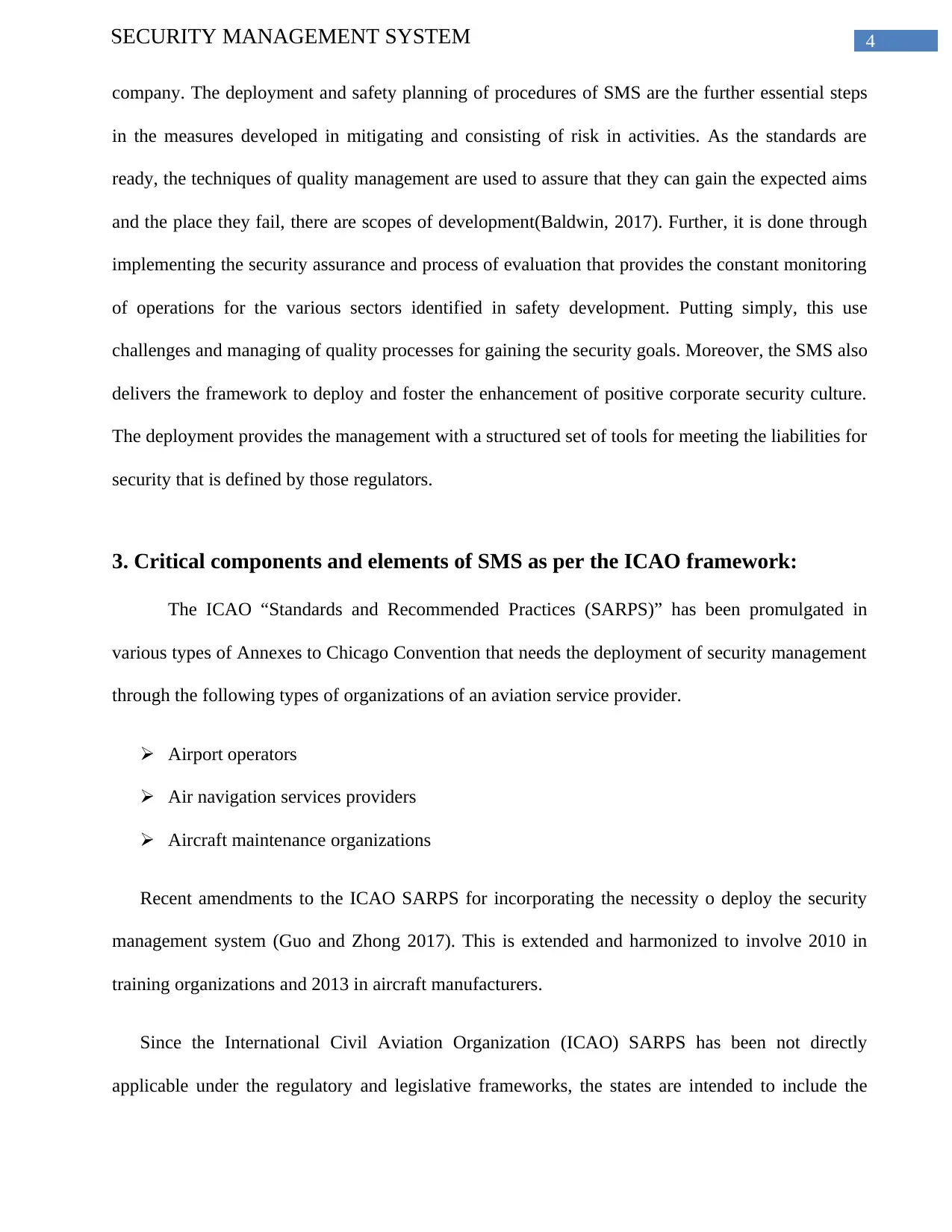
4SECURITY MANAGEMENT SYSTEM
company. The deployment and safety planning of procedures of SMS are the further essential steps
in the measures developed in mitigating and consisting of risk in activities. As the standards are
ready, the techniques of quality management are used to assure that they can gain the expected aims
and the place they fail, there are scopes of development(Baldwin, 2017). Further, it is done through
implementing the security assurance and process of evaluation that provides the constant monitoring
of operations for the various sectors identified in safety development. Putting simply, this use
challenges and managing of quality processes for gaining the security goals. Moreover, the SMS also
delivers the framework to deploy and foster the enhancement of positive corporate security culture.
The deployment provides the management with a structured set of tools for meeting the liabilities for
security that is defined by those regulators.
3. Critical components and elements of SMS as per the ICAO framework:
The ICAO “Standards and Recommended Practices (SARPS)” has been promulgated in
various types of Annexes to Chicago Convention that needs the deployment of security management
through the following types of organizations of an aviation service provider.
Airport operators
Air navigation services providers
Aircraft maintenance organizations
Recent amendments to the ICAO SARPS for incorporating the necessity o deploy the security
management system (Guo and Zhong 2017). This is extended and harmonized to involve 2010 in
training organizations and 2013 in aircraft manufacturers.
Since the International Civil Aviation Organization (ICAO) SARPS has been not directly
applicable under the regulatory and legislative frameworks, the states are intended to include the
company. The deployment and safety planning of procedures of SMS are the further essential steps
in the measures developed in mitigating and consisting of risk in activities. As the standards are
ready, the techniques of quality management are used to assure that they can gain the expected aims
and the place they fail, there are scopes of development(Baldwin, 2017). Further, it is done through
implementing the security assurance and process of evaluation that provides the constant monitoring
of operations for the various sectors identified in safety development. Putting simply, this use
challenges and managing of quality processes for gaining the security goals. Moreover, the SMS also
delivers the framework to deploy and foster the enhancement of positive corporate security culture.
The deployment provides the management with a structured set of tools for meeting the liabilities for
security that is defined by those regulators.
3. Critical components and elements of SMS as per the ICAO framework:
The ICAO “Standards and Recommended Practices (SARPS)” has been promulgated in
various types of Annexes to Chicago Convention that needs the deployment of security management
through the following types of organizations of an aviation service provider.
Airport operators
Air navigation services providers
Aircraft maintenance organizations
Recent amendments to the ICAO SARPS for incorporating the necessity o deploy the security
management system (Guo and Zhong 2017). This is extended and harmonized to involve 2010 in
training organizations and 2013 in aircraft manufacturers.
Since the International Civil Aviation Organization (ICAO) SARPS has been not directly
applicable under the regulatory and legislative frameworks, the states are intended to include the
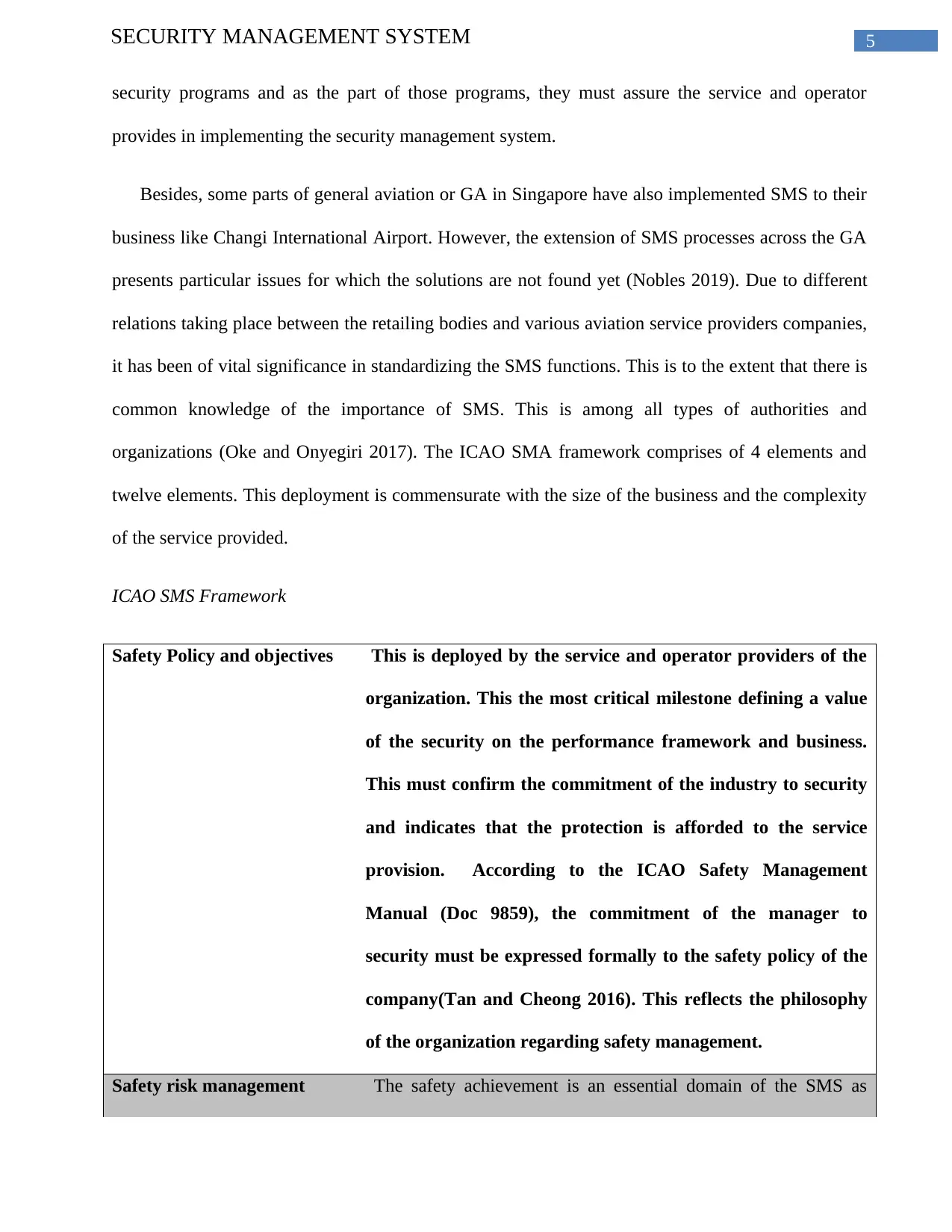
5SECURITY MANAGEMENT SYSTEM
security programs and as the part of those programs, they must assure the service and operator
provides in implementing the security management system.
Besides, some parts of general aviation or GA in Singapore have also implemented SMS to their
business like Changi International Airport. However, the extension of SMS processes across the GA
presents particular issues for which the solutions are not found yet (Nobles 2019). Due to different
relations taking place between the retailing bodies and various aviation service providers companies,
it has been of vital significance in standardizing the SMS functions. This is to the extent that there is
common knowledge of the importance of SMS. This is among all types of authorities and
organizations (Oke and Onyegiri 2017). The ICAO SMA framework comprises of 4 elements and
twelve elements. This deployment is commensurate with the size of the business and the complexity
of the service provided.
ICAO SMS Framework
Safety Policy and objectives This is deployed by the service and operator providers of the
organization. This the most critical milestone defining a value
of the security on the performance framework and business.
This must confirm the commitment of the industry to security
and indicates that the protection is afforded to the service
provision. According to the ICAO Safety Management
Manual (Doc 9859), the commitment of the manager to
security must be expressed formally to the safety policy of the
company(Tan and Cheong 2016). This reflects the philosophy
of the organization regarding safety management.
Safety risk management The safety achievement is an essential domain of the SMS as
security programs and as the part of those programs, they must assure the service and operator
provides in implementing the security management system.
Besides, some parts of general aviation or GA in Singapore have also implemented SMS to their
business like Changi International Airport. However, the extension of SMS processes across the GA
presents particular issues for which the solutions are not found yet (Nobles 2019). Due to different
relations taking place between the retailing bodies and various aviation service providers companies,
it has been of vital significance in standardizing the SMS functions. This is to the extent that there is
common knowledge of the importance of SMS. This is among all types of authorities and
organizations (Oke and Onyegiri 2017). The ICAO SMA framework comprises of 4 elements and
twelve elements. This deployment is commensurate with the size of the business and the complexity
of the service provided.
ICAO SMS Framework
Safety Policy and objectives This is deployed by the service and operator providers of the
organization. This the most critical milestone defining a value
of the security on the performance framework and business.
This must confirm the commitment of the industry to security
and indicates that the protection is afforded to the service
provision. According to the ICAO Safety Management
Manual (Doc 9859), the commitment of the manager to
security must be expressed formally to the safety policy of the
company(Tan and Cheong 2016). This reflects the philosophy
of the organization regarding safety management.
Safety risk management The safety achievement is an essential domain of the SMS as
⊘ This is a preview!⊘
Do you want full access?
Subscribe today to unlock all pages.

Trusted by 1+ million students worldwide
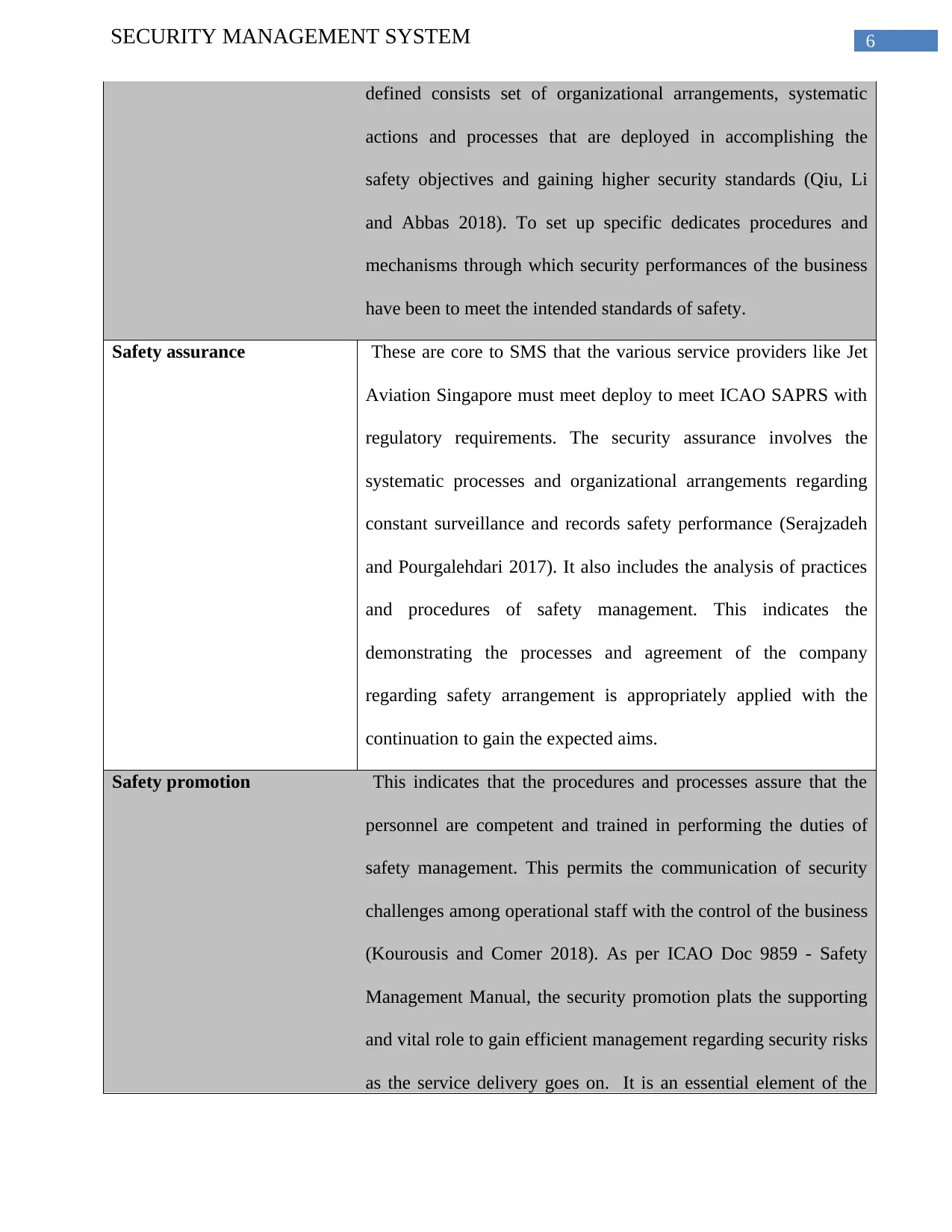
6SECURITY MANAGEMENT SYSTEM
defined consists set of organizational arrangements, systematic
actions and processes that are deployed in accomplishing the
safety objectives and gaining higher security standards (Qiu, Li
and Abbas 2018). To set up specific dedicates procedures and
mechanisms through which security performances of the business
have been to meet the intended standards of safety.
Safety assurance These are core to SMS that the various service providers like Jet
Aviation Singapore must meet deploy to meet ICAO SAPRS with
regulatory requirements. The security assurance involves the
systematic processes and organizational arrangements regarding
constant surveillance and records safety performance (Serajzadeh
and Pourgalehdari 2017). It also includes the analysis of practices
and procedures of safety management. This indicates the
demonstrating the processes and agreement of the company
regarding safety arrangement is appropriately applied with the
continuation to gain the expected aims.
Safety promotion This indicates that the procedures and processes assure that the
personnel are competent and trained in performing the duties of
safety management. This permits the communication of security
challenges among operational staff with the control of the business
(Kourousis and Comer 2018). As per ICAO Doc 9859 - Safety
Management Manual, the security promotion plats the supporting
and vital role to gain efficient management regarding security risks
as the service delivery goes on. It is an essential element of the
defined consists set of organizational arrangements, systematic
actions and processes that are deployed in accomplishing the
safety objectives and gaining higher security standards (Qiu, Li
and Abbas 2018). To set up specific dedicates procedures and
mechanisms through which security performances of the business
have been to meet the intended standards of safety.
Safety assurance These are core to SMS that the various service providers like Jet
Aviation Singapore must meet deploy to meet ICAO SAPRS with
regulatory requirements. The security assurance involves the
systematic processes and organizational arrangements regarding
constant surveillance and records safety performance (Serajzadeh
and Pourgalehdari 2017). It also includes the analysis of practices
and procedures of safety management. This indicates the
demonstrating the processes and agreement of the company
regarding safety arrangement is appropriately applied with the
continuation to gain the expected aims.
Safety promotion This indicates that the procedures and processes assure that the
personnel are competent and trained in performing the duties of
safety management. This permits the communication of security
challenges among operational staff with the control of the business
(Kourousis and Comer 2018). As per ICAO Doc 9859 - Safety
Management Manual, the security promotion plats the supporting
and vital role to gain efficient management regarding security risks
as the service delivery goes on. It is an essential element of the
Paraphrase This Document
Need a fresh take? Get an instant paraphrase of this document with our AI Paraphraser
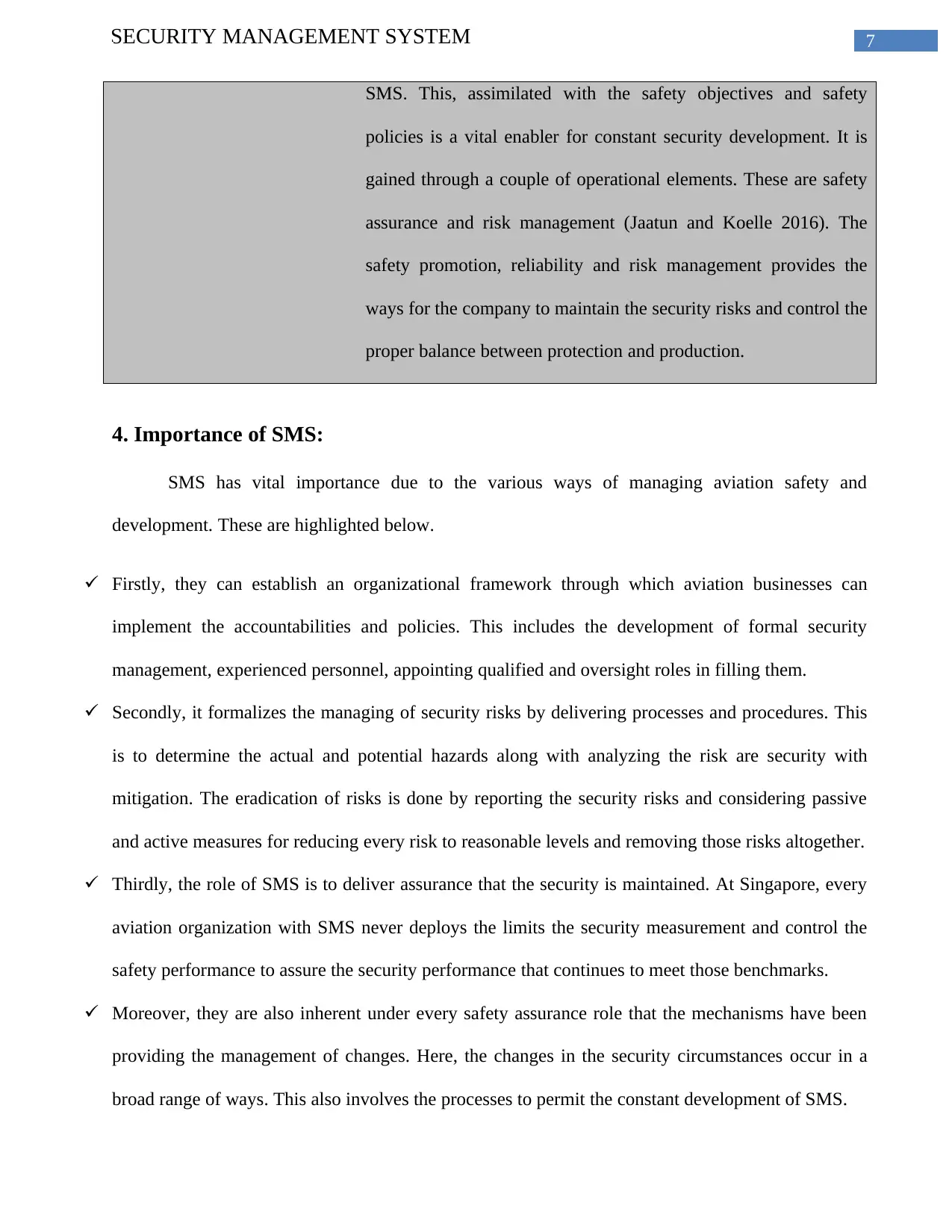
7SECURITY MANAGEMENT SYSTEM
SMS. This, assimilated with the safety objectives and safety
policies is a vital enabler for constant security development. It is
gained through a couple of operational elements. These are safety
assurance and risk management (Jaatun and Koelle 2016). The
safety promotion, reliability and risk management provides the
ways for the company to maintain the security risks and control the
proper balance between protection and production.
4. Importance of SMS:
SMS has vital importance due to the various ways of managing aviation safety and
development. These are highlighted below.
Firstly, they can establish an organizational framework through which aviation businesses can
implement the accountabilities and policies. This includes the development of formal security
management, experienced personnel, appointing qualified and oversight roles in filling them.
Secondly, it formalizes the managing of security risks by delivering processes and procedures. This
is to determine the actual and potential hazards along with analyzing the risk are security with
mitigation. The eradication of risks is done by reporting the security risks and considering passive
and active measures for reducing every risk to reasonable levels and removing those risks altogether.
Thirdly, the role of SMS is to deliver assurance that the security is maintained. At Singapore, every
aviation organization with SMS never deploys the limits the security measurement and control the
safety performance to assure the security performance that continues to meet those benchmarks.
Moreover, they are also inherent under every safety assurance role that the mechanisms have been
providing the management of changes. Here, the changes in the security circumstances occur in a
broad range of ways. This also involves the processes to permit the constant development of SMS.
SMS. This, assimilated with the safety objectives and safety
policies is a vital enabler for constant security development. It is
gained through a couple of operational elements. These are safety
assurance and risk management (Jaatun and Koelle 2016). The
safety promotion, reliability and risk management provides the
ways for the company to maintain the security risks and control the
proper balance between protection and production.
4. Importance of SMS:
SMS has vital importance due to the various ways of managing aviation safety and
development. These are highlighted below.
Firstly, they can establish an organizational framework through which aviation businesses can
implement the accountabilities and policies. This includes the development of formal security
management, experienced personnel, appointing qualified and oversight roles in filling them.
Secondly, it formalizes the managing of security risks by delivering processes and procedures. This
is to determine the actual and potential hazards along with analyzing the risk are security with
mitigation. The eradication of risks is done by reporting the security risks and considering passive
and active measures for reducing every risk to reasonable levels and removing those risks altogether.
Thirdly, the role of SMS is to deliver assurance that the security is maintained. At Singapore, every
aviation organization with SMS never deploys the limits the security measurement and control the
safety performance to assure the security performance that continues to meet those benchmarks.
Moreover, they are also inherent under every safety assurance role that the mechanisms have been
providing the management of changes. Here, the changes in the security circumstances occur in a
broad range of ways. This also involves the processes to permit the constant development of SMS.
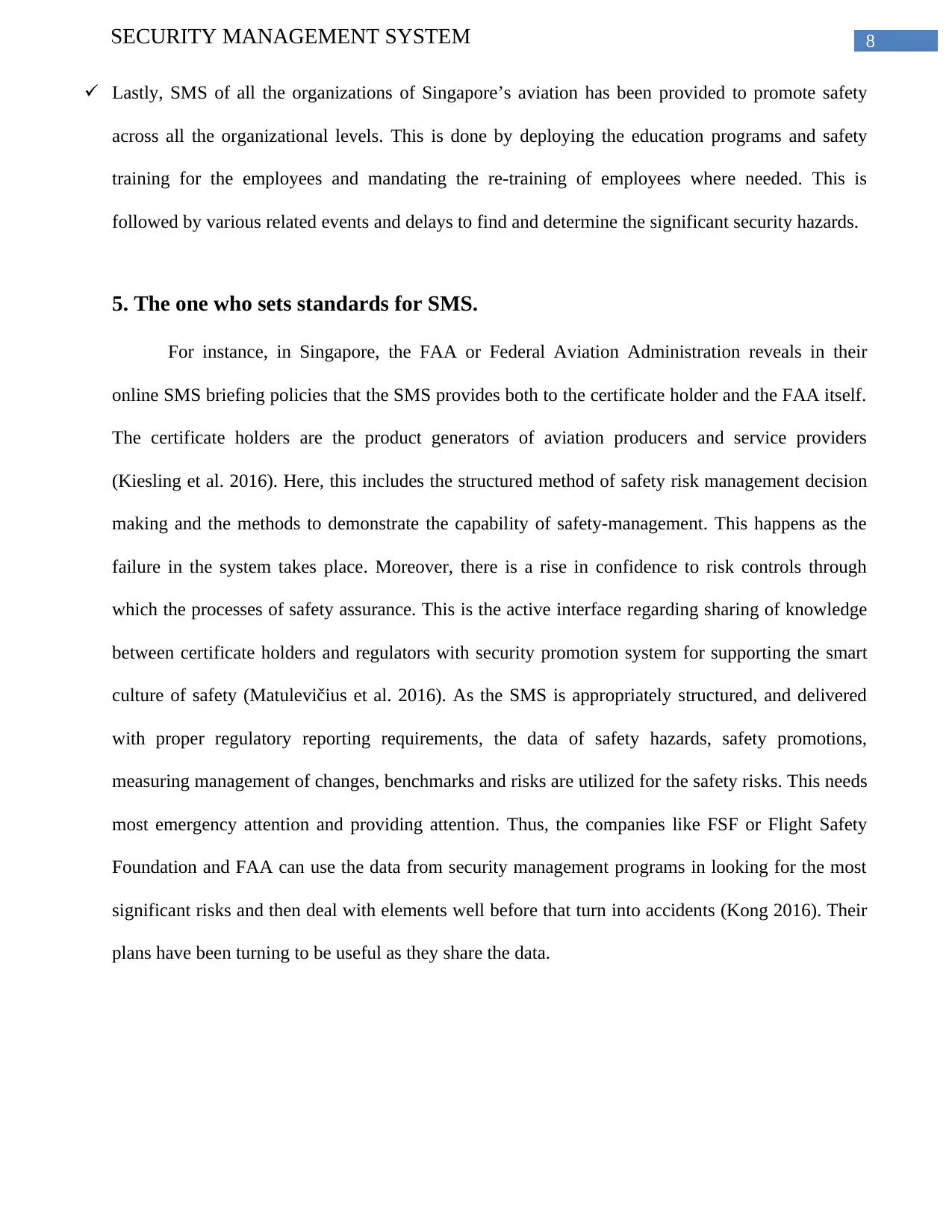
8SECURITY MANAGEMENT SYSTEM
Lastly, SMS of all the organizations of Singapore’s aviation has been provided to promote safety
across all the organizational levels. This is done by deploying the education programs and safety
training for the employees and mandating the re-training of employees where needed. This is
followed by various related events and delays to find and determine the significant security hazards.
5. The one who sets standards for SMS.
For instance, in Singapore, the FAA or Federal Aviation Administration reveals in their
online SMS briefing policies that the SMS provides both to the certificate holder and the FAA itself.
The certificate holders are the product generators of aviation producers and service providers
(Kiesling et al. 2016). Here, this includes the structured method of safety risk management decision
making and the methods to demonstrate the capability of safety-management. This happens as the
failure in the system takes place. Moreover, there is a rise in confidence to risk controls through
which the processes of safety assurance. This is the active interface regarding sharing of knowledge
between certificate holders and regulators with security promotion system for supporting the smart
culture of safety (Matulevičius et al. 2016). As the SMS is appropriately structured, and delivered
with proper regulatory reporting requirements, the data of safety hazards, safety promotions,
measuring management of changes, benchmarks and risks are utilized for the safety risks. This needs
most emergency attention and providing attention. Thus, the companies like FSF or Flight Safety
Foundation and FAA can use the data from security management programs in looking for the most
significant risks and then deal with elements well before that turn into accidents (Kong 2016). Their
plans have been turning to be useful as they share the data.
Lastly, SMS of all the organizations of Singapore’s aviation has been provided to promote safety
across all the organizational levels. This is done by deploying the education programs and safety
training for the employees and mandating the re-training of employees where needed. This is
followed by various related events and delays to find and determine the significant security hazards.
5. The one who sets standards for SMS.
For instance, in Singapore, the FAA or Federal Aviation Administration reveals in their
online SMS briefing policies that the SMS provides both to the certificate holder and the FAA itself.
The certificate holders are the product generators of aviation producers and service providers
(Kiesling et al. 2016). Here, this includes the structured method of safety risk management decision
making and the methods to demonstrate the capability of safety-management. This happens as the
failure in the system takes place. Moreover, there is a rise in confidence to risk controls through
which the processes of safety assurance. This is the active interface regarding sharing of knowledge
between certificate holders and regulators with security promotion system for supporting the smart
culture of safety (Matulevičius et al. 2016). As the SMS is appropriately structured, and delivered
with proper regulatory reporting requirements, the data of safety hazards, safety promotions,
measuring management of changes, benchmarks and risks are utilized for the safety risks. This needs
most emergency attention and providing attention. Thus, the companies like FSF or Flight Safety
Foundation and FAA can use the data from security management programs in looking for the most
significant risks and then deal with elements well before that turn into accidents (Kong 2016). Their
plans have been turning to be useful as they share the data.
⊘ This is a preview!⊘
Do you want full access?
Subscribe today to unlock all pages.

Trusted by 1+ million students worldwide
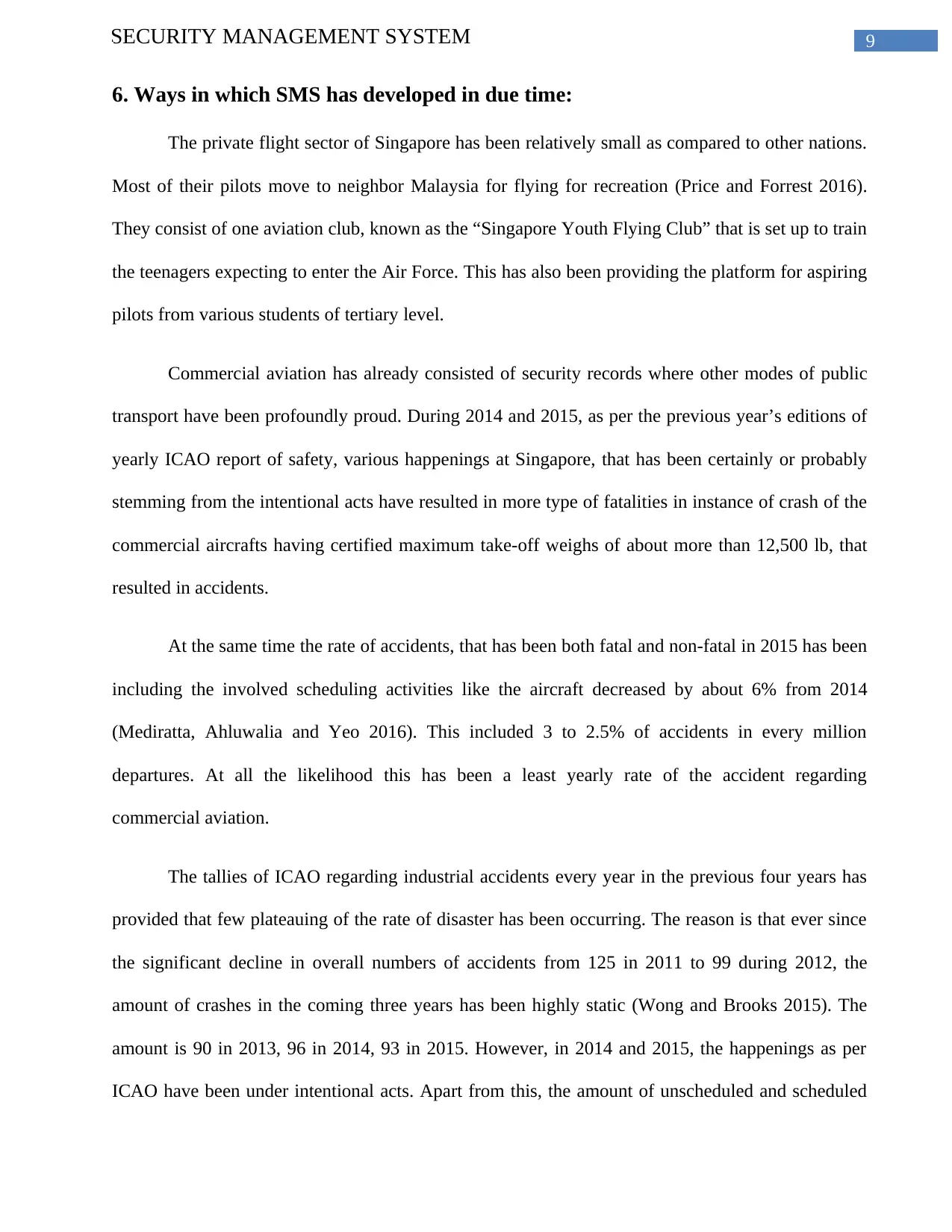
9SECURITY MANAGEMENT SYSTEM
6. Ways in which SMS has developed in due time:
The private flight sector of Singapore has been relatively small as compared to other nations.
Most of their pilots move to neighbor Malaysia for flying for recreation (Price and Forrest 2016).
They consist of one aviation club, known as the “Singapore Youth Flying Club” that is set up to train
the teenagers expecting to enter the Air Force. This has also been providing the platform for aspiring
pilots from various students of tertiary level.
Commercial aviation has already consisted of security records where other modes of public
transport have been profoundly proud. During 2014 and 2015, as per the previous year’s editions of
yearly ICAO report of safety, various happenings at Singapore, that has been certainly or probably
stemming from the intentional acts have resulted in more type of fatalities in instance of crash of the
commercial aircrafts having certified maximum take-off weighs of about more than 12,500 lb, that
resulted in accidents.
At the same time the rate of accidents, that has been both fatal and non-fatal in 2015 has been
including the involved scheduling activities like the aircraft decreased by about 6% from 2014
(Mediratta, Ahluwalia and Yeo 2016). This included 3 to 2.5% of accidents in every million
departures. At all the likelihood this has been a least yearly rate of the accident regarding
commercial aviation.
The tallies of ICAO regarding industrial accidents every year in the previous four years has
provided that few plateauing of the rate of disaster has been occurring. The reason is that ever since
the significant decline in overall numbers of accidents from 125 in 2011 to 99 during 2012, the
amount of crashes in the coming three years has been highly static (Wong and Brooks 2015). The
amount is 90 in 2013, 96 in 2014, 93 in 2015. However, in 2014 and 2015, the happenings as per
ICAO have been under intentional acts. Apart from this, the amount of unscheduled and scheduled
6. Ways in which SMS has developed in due time:
The private flight sector of Singapore has been relatively small as compared to other nations.
Most of their pilots move to neighbor Malaysia for flying for recreation (Price and Forrest 2016).
They consist of one aviation club, known as the “Singapore Youth Flying Club” that is set up to train
the teenagers expecting to enter the Air Force. This has also been providing the platform for aspiring
pilots from various students of tertiary level.
Commercial aviation has already consisted of security records where other modes of public
transport have been profoundly proud. During 2014 and 2015, as per the previous year’s editions of
yearly ICAO report of safety, various happenings at Singapore, that has been certainly or probably
stemming from the intentional acts have resulted in more type of fatalities in instance of crash of the
commercial aircrafts having certified maximum take-off weighs of about more than 12,500 lb, that
resulted in accidents.
At the same time the rate of accidents, that has been both fatal and non-fatal in 2015 has been
including the involved scheduling activities like the aircraft decreased by about 6% from 2014
(Mediratta, Ahluwalia and Yeo 2016). This included 3 to 2.5% of accidents in every million
departures. At all the likelihood this has been a least yearly rate of the accident regarding
commercial aviation.
The tallies of ICAO regarding industrial accidents every year in the previous four years has
provided that few plateauing of the rate of disaster has been occurring. The reason is that ever since
the significant decline in overall numbers of accidents from 125 in 2011 to 99 during 2012, the
amount of crashes in the coming three years has been highly static (Wong and Brooks 2015). The
amount is 90 in 2013, 96 in 2014, 93 in 2015. However, in 2014 and 2015, the happenings as per
ICAO have been under intentional acts. Apart from this, the amount of unscheduled and scheduled
Paraphrase This Document
Need a fresh take? Get an instant paraphrase of this document with our AI Paraphraser
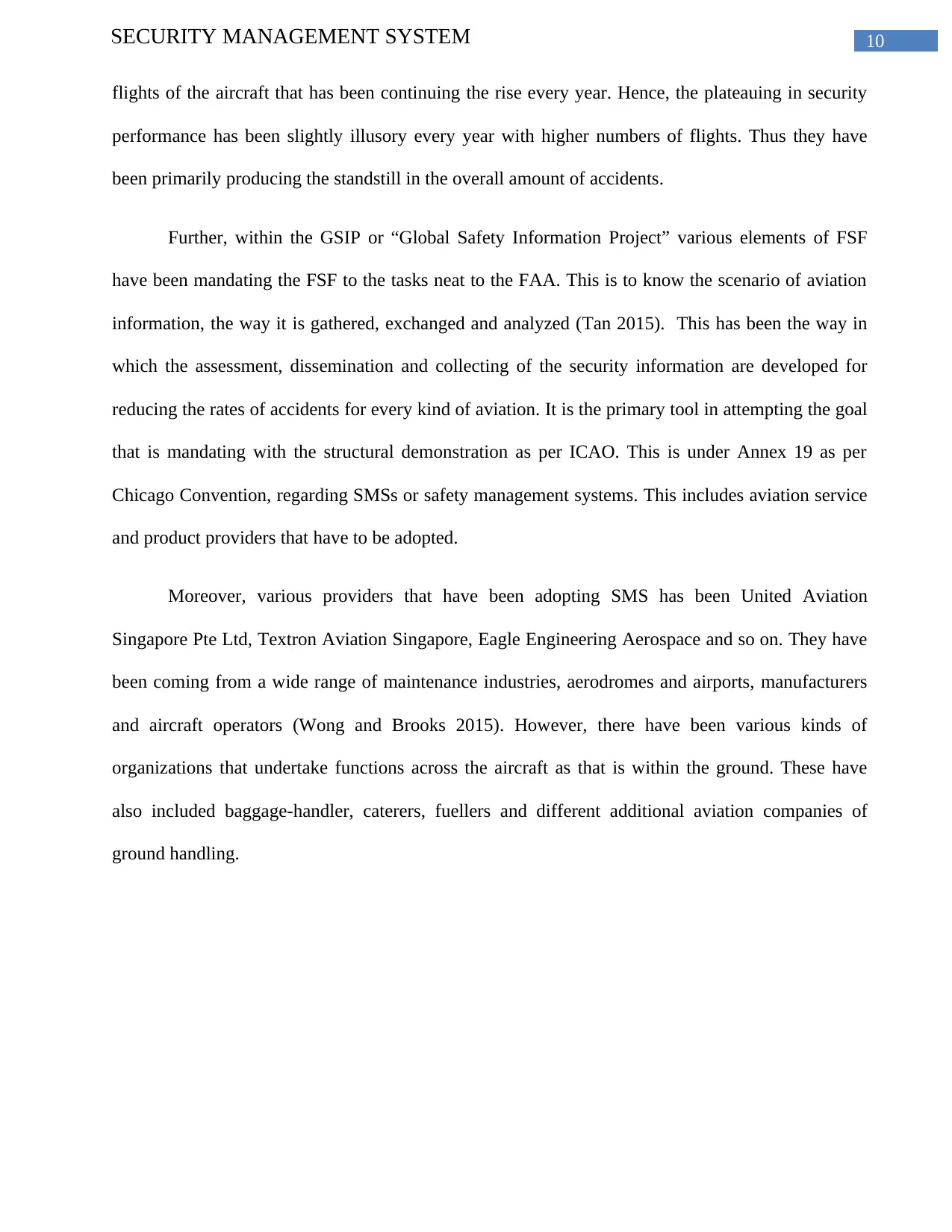
10SECURITY MANAGEMENT SYSTEM
flights of the aircraft that has been continuing the rise every year. Hence, the plateauing in security
performance has been slightly illusory every year with higher numbers of flights. Thus they have
been primarily producing the standstill in the overall amount of accidents.
Further, within the GSIP or “Global Safety Information Project” various elements of FSF
have been mandating the FSF to the tasks neat to the FAA. This is to know the scenario of aviation
information, the way it is gathered, exchanged and analyzed (Tan 2015). This has been the way in
which the assessment, dissemination and collecting of the security information are developed for
reducing the rates of accidents for every kind of aviation. It is the primary tool in attempting the goal
that is mandating with the structural demonstration as per ICAO. This is under Annex 19 as per
Chicago Convention, regarding SMSs or safety management systems. This includes aviation service
and product providers that have to be adopted.
Moreover, various providers that have been adopting SMS has been United Aviation
Singapore Pte Ltd, Textron Aviation Singapore, Eagle Engineering Aerospace and so on. They have
been coming from a wide range of maintenance industries, aerodromes and airports, manufacturers
and aircraft operators (Wong and Brooks 2015). However, there have been various kinds of
organizations that undertake functions across the aircraft as that is within the ground. These have
also included baggage-handler, caterers, fuellers and different additional aviation companies of
ground handling.
flights of the aircraft that has been continuing the rise every year. Hence, the plateauing in security
performance has been slightly illusory every year with higher numbers of flights. Thus they have
been primarily producing the standstill in the overall amount of accidents.
Further, within the GSIP or “Global Safety Information Project” various elements of FSF
have been mandating the FSF to the tasks neat to the FAA. This is to know the scenario of aviation
information, the way it is gathered, exchanged and analyzed (Tan 2015). This has been the way in
which the assessment, dissemination and collecting of the security information are developed for
reducing the rates of accidents for every kind of aviation. It is the primary tool in attempting the goal
that is mandating with the structural demonstration as per ICAO. This is under Annex 19 as per
Chicago Convention, regarding SMSs or safety management systems. This includes aviation service
and product providers that have to be adopted.
Moreover, various providers that have been adopting SMS has been United Aviation
Singapore Pte Ltd, Textron Aviation Singapore, Eagle Engineering Aerospace and so on. They have
been coming from a wide range of maintenance industries, aerodromes and airports, manufacturers
and aircraft operators (Wong and Brooks 2015). However, there have been various kinds of
organizations that undertake functions across the aircraft as that is within the ground. These have
also included baggage-handler, caterers, fuellers and different additional aviation companies of
ground handling.
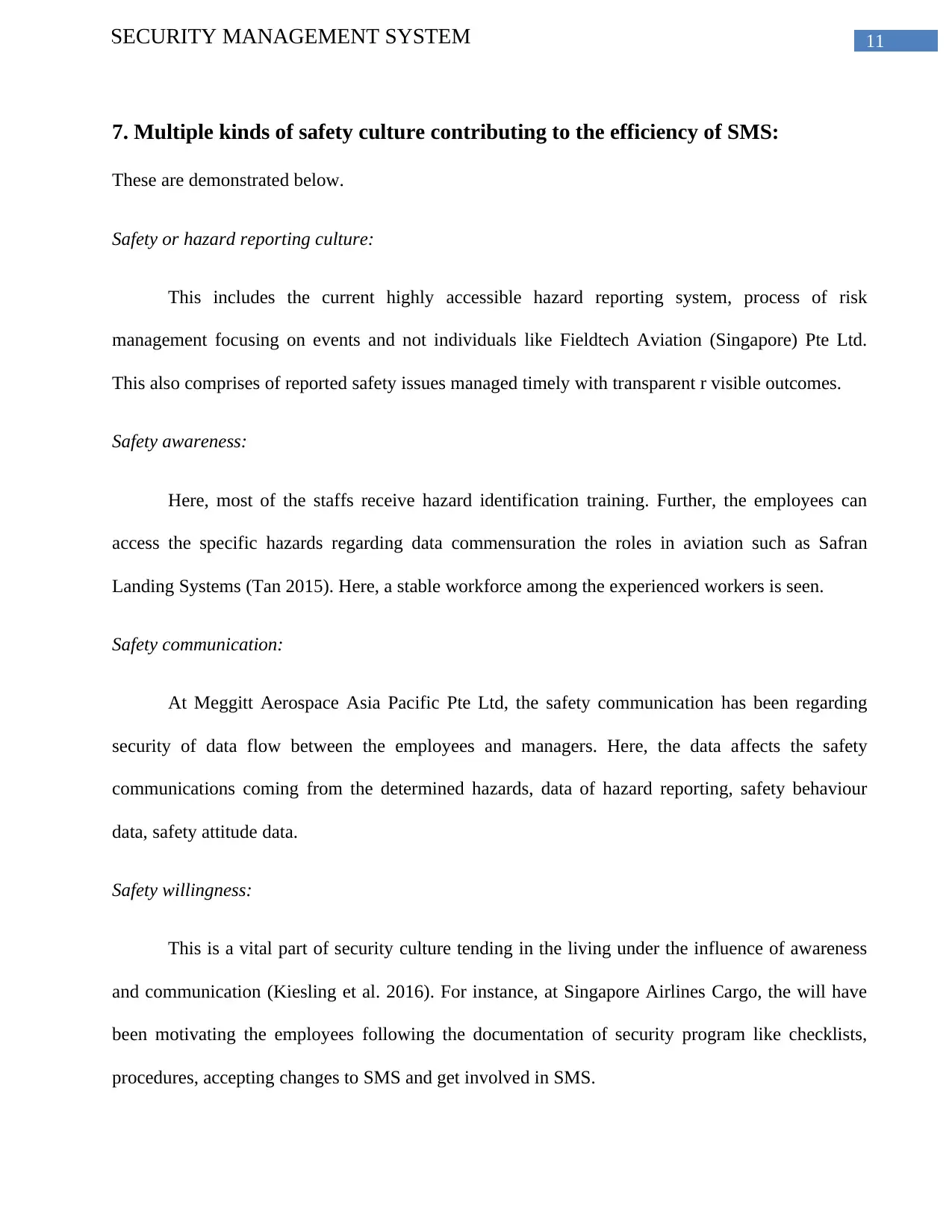
11SECURITY MANAGEMENT SYSTEM
7. Multiple kinds of safety culture contributing to the efficiency of SMS:
These are demonstrated below.
Safety or hazard reporting culture:
This includes the current highly accessible hazard reporting system, process of risk
management focusing on events and not individuals like Fieldtech Aviation (Singapore) Pte Ltd.
This also comprises of reported safety issues managed timely with transparent r visible outcomes.
Safety awareness:
Here, most of the staffs receive hazard identification training. Further, the employees can
access the specific hazards regarding data commensuration the roles in aviation such as Safran
Landing Systems (Tan 2015). Here, a stable workforce among the experienced workers is seen.
Safety communication:
At Meggitt Aerospace Asia Pacific Pte Ltd, the safety communication has been regarding
security of data flow between the employees and managers. Here, the data affects the safety
communications coming from the determined hazards, data of hazard reporting, safety behaviour
data, safety attitude data.
Safety willingness:
This is a vital part of security culture tending in the living under the influence of awareness
and communication (Kiesling et al. 2016). For instance, at Singapore Airlines Cargo, the will have
been motivating the employees following the documentation of security program like checklists,
procedures, accepting changes to SMS and get involved in SMS.
7. Multiple kinds of safety culture contributing to the efficiency of SMS:
These are demonstrated below.
Safety or hazard reporting culture:
This includes the current highly accessible hazard reporting system, process of risk
management focusing on events and not individuals like Fieldtech Aviation (Singapore) Pte Ltd.
This also comprises of reported safety issues managed timely with transparent r visible outcomes.
Safety awareness:
Here, most of the staffs receive hazard identification training. Further, the employees can
access the specific hazards regarding data commensuration the roles in aviation such as Safran
Landing Systems (Tan 2015). Here, a stable workforce among the experienced workers is seen.
Safety communication:
At Meggitt Aerospace Asia Pacific Pte Ltd, the safety communication has been regarding
security of data flow between the employees and managers. Here, the data affects the safety
communications coming from the determined hazards, data of hazard reporting, safety behaviour
data, safety attitude data.
Safety willingness:
This is a vital part of security culture tending in the living under the influence of awareness
and communication (Kiesling et al. 2016). For instance, at Singapore Airlines Cargo, the will have
been motivating the employees following the documentation of security program like checklists,
procedures, accepting changes to SMS and get involved in SMS.
⊘ This is a preview!⊘
Do you want full access?
Subscribe today to unlock all pages.

Trusted by 1+ million students worldwide
1 out of 16
Related Documents
Your All-in-One AI-Powered Toolkit for Academic Success.
+13062052269
info@desklib.com
Available 24*7 on WhatsApp / Email
![[object Object]](/_next/static/media/star-bottom.7253800d.svg)
Unlock your academic potential
Copyright © 2020–2025 A2Z Services. All Rights Reserved. Developed and managed by ZUCOL.




![Management 2 - [Company Name]: Safety and Risk Management Report](/_next/image/?url=https%3A%2F%2Fdesklib.com%2Fmedia%2Fimages%2Fkd%2F57efae6be7764504982d63a38acdd596.jpg&w=256&q=75)
